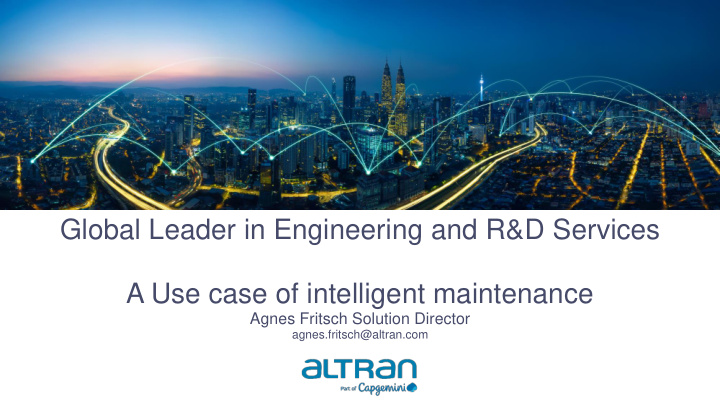



Global Leader in Engineering and R&D Services A Use case of intelligent maintenance Agnes Fritsch Solution Director agnes.fritsch@altran.com
3 expertise domains to engineer tomorrow Our Global Service Lines help the world’s largest innovators engineer the products and services of tomorrow by leveraging our experts, labs, tools and frameworks around the globe. Intelligent Maintenance is at the intersection of: 40% 35% 25% Product & Systems Digital & Software Industrial Operations Engineering of of of engineers engineers engineers • • • Digital Experience Design Product Design & Development Manufacturing Engineering & Technology • • Systems Engineering Software Product Engineering & • Cybersecurity Supply Chain & Quality Management • Mechanical Engineering • • • IT & OT Systems Integration Operations & Asset Management Silicon, Electronics & Embedded • • Advanced Network Technology & IoT Systems Network Operations & Transformation • • • Data Analytics & AI Testing & Compliance Product Support & Sustenance
We work with global innovation leaders across industries. Automotive Aeronautics Space, Rail, Infrastructure Energy Industrial & Life Sciences Communications Semiconductor Software & Finance & Defense & Transport Consumer & Electronics Internet Public Sector & Naval
Let’s put a focus on our client Orano Automotive Aeronautics Space, Rail, Infrastructure Energy Industrial & Life Sciences Communications Semiconductor Software & Finance & Defense & Transport Consumer & Electronics Internet Public Sector & Naval
MANUFACTURING - DIGITAL TWIN DATA-DRIVEN IMPROVEMENT OF PREVENT AUTOMATED ARM PRODUCTION QUALITY OUTAGE EQUIPMENT INSTALLED IN A CRITICAL ENVIRONMENT T ELESCOPIC MECHANICAL ARMS USE CASE: REAL TIME ASSET DEPLOYED COLLECTING DATA FROM AN TRAINING MEASUREMENT AUTOMATED ARM TO REDUCE INTELLIGENT MAINTENANCE ROTATIONS, SPEED, MECHANICAL BREADOWNS OCCURRENCES ON PREDICT FAILURES CONSTRAINTS LEGACY SYSTEMS NOT ONLY ABOUT IT, PEOPLE MATTER
Connected maintenance with IoT on legacy systems ISO 55000 family standards Maintenance ISO 13374 series of standards Connected maintenance adding data to legacy systems with IoT solutions makes sense: Preventive Corrective • Equipment area not easily accessible • From corrective (fail and fix) to conditional maintenance • Adding diagnostic and monitoring for: Periodic • Preventing/predicting • Learning, self-learning • Training Condition- based Cost efficiency of adding IoT rather than changing the machine fleet (up to 1000 machines) Cost of failures are currently (up to 1000 machines) : ????? Per year? Per failure?
AUTOMATED ARMS in the NUCLEAR INDUSTRY MT 200, master slave telescopic mechanical arm, suitable for high capacity and heavy remote manipulations (20 daN). Hot zone Target: 8 cells, each including 15 to 20 arms Cold zone Detinge La Calhène with a 80 cm 7 width wall
AUTOMATED ARMS in the NUCLEAR INDUSTRY: 1st challenge Large movements / Small movements First challenge: Modelling and choice of the sensors: 1. and 2. inertial sensors (X, Y) 3. Counterweight Distance measurements (ZMAN/ZE) (Z): IR sensor + Button 4. Constraint: putting the sensors on the « cold » zone requires calculating the real » movements Rising on the « hot » zone and not measuring directly 5. Modelling requires defining critical parameters and assessing relevant thresholds Detinge La Calhène Designing and adding a set of sensors and data collectors: - To measure the subsystems movement - To collect and transmit the data via a wireless infrastructure - To expose the results: MMI offering a visualization of angles X/Y, Z, ZMAN/ZE, the thresholds detection, the utilization rates 8
AUTOMATED ARMS in the NUCLEAR INDUSTRIAL: 2nd challenge Adding the IoT without interferences, disturbance or reduction of the MTBF Second challenge: designing and bringing connectivity - First trial: using LoRa2.4 GHz (sensors + GTW) - Second trial: moving to LoRa 868 MHz technology for the alerts + WiFi for the connectivity + using wired sensors => OK and complying to the standards - Interfacing to the command of the MT200 without compromising security features => synchronize the supervision card with NTP - Modelling for the integration feasibility - Powering the sensor set-up without having interferences between both systems - Compliance to the standards Real time constraints: LoRa Alerts, WiFi (not done yet), kinetics calculations are not done on the edge (data collected every 100ms) 9
AUTOMATED ARMS in the NUCLEAR INDUSTRY: 3rd challenge Collecting the data, checking the relevancy, creating value Third challenge: collecting the data to create value: - Checking the data and algorithms relevance: Euler angles (Tait Bryan with pitch/roll/yaw like evalutation) was sufficient, no need to use quaternions. - Analysis of failure causes: quantifying critical parameters and thresholds (Orano) - Anticipation of failures (combining utilization rates and large movements detection above thresholds - Training the collaborators: the client will combine training sessions of collaborators with data signatures and references collected by the IoT system. Cost efficiency: Remplacing 1000 arms vs equipping them with the IoT system: cost of the “arm” .vs. 1600 - to 2000 Euros for the IoT solution. - Average failure cost is huge compared to setting this IoT solution (not disclosed by Orano) - Mutualization of the maintenance operations brings a huge benefit (not disclosed by Orano) 10
Recommend
More recommend